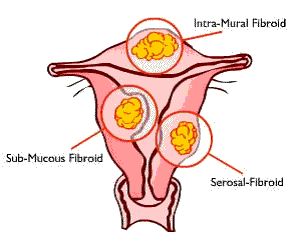
A myoma or fibroid is a tumor of the uterus (womb) that is non-cancerous. Fibroids are very common and occur in up to 40% of all women. They develop from the smooth muscle cells of the uterus and can grow inside or outside of your uterus. Most fibroids cause no problems. However, depending on the size and location, fibroids can cause heavy bleeding, painful, or irregular periods, pelvic pain, infertility, early pregnancy loss and bowel or bladder problems.
Your medical history and a pelvic exam are necessary in diagnosing fibroids. Listed below are tests that may also be used to confirm the diagnosis.
Most fibroids do not require therapy. Mild discomfort and slightly heavy bleeding may be improved with medications such as Motrin or naproxen. Oral contraceptives (birth control pills) or progesterone may also be beneficial but should not be used in a woman who desires pregnancy. If a woman is having significant symptoms from the fibroid (s) or if the endometrial cavity is deformed by the fibroids, surgical treatment is necessary. Drugs such as Lupron may be useful pre-operative therapies for some patients but do not remove or shrink fibroids permanently.
A relatively new procedure called uterine artery embolization (UAE) is gaining popularity. In such procedures, tiny beads are placed in the uterine arteries to block the supply of blood to the uterus, causing the fibroids to shrink. While this procedure appears to have some potential, there is little evidence to show that UAE is safe for women who are trying to get pregnant or may want to get pregnant in the future.
The definitive surgery for symptomatic uterine fibroids is hysterectomy (removal of the uterus). However, this is rarely appropriate for women trying to conceive or who want to get pregnant in the future. The best option for treatment of fibroids in women who are trying to conceive is to do a myomectomy. This means to remove the fibroids, but leave the uterus.
Advanced Reproductive Medicine & Gynecology of Hawaii
Helping to Create New Beginnings